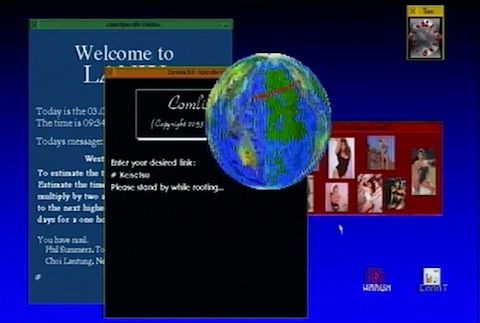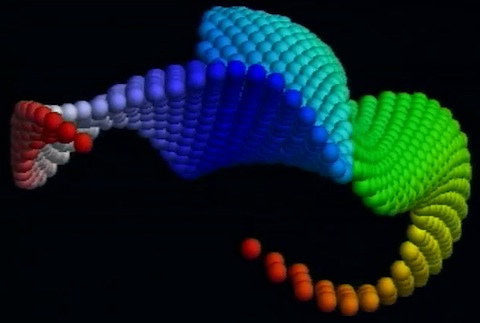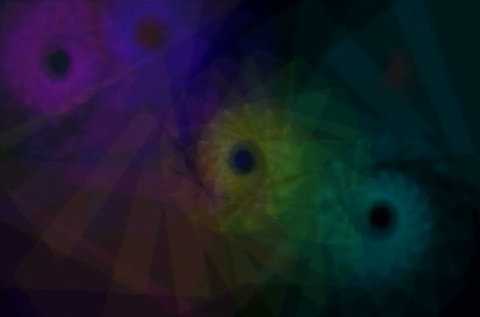
| Home | News | Demo Stuffs | Game Stuffs | Serious Stuffs | Travel Reports | Multimedia | Humour |
A Classic Revisited..Autowaschen Verboten (1994) by Lazer..
A hasty explanation comes spiralling in first.
In this case, I've been on a little bit of a nostalgic early Falcon demo scene tour, having finally managed to find a way of overcoming my mortuary-bound track record of adding some decent storage to my Falcy's. In this case, this one is for my other (Centurbo 2) Falcon. The device that does the deed is an Adtron CF-Card to SCSI converter cunningly combined with one of my old RS Components SCSI enclosures from 'back in the day'. It has been even more cleverly combined with a CF-Card that actually chooses to work. (Note to self, the original non-working 'Ebay cheap' Kingston card was almost certainly a faker!)
Anyway, I'm slowly assembling a ready-to-run archive collection of my favourite old demos on one of the partitions. Such fond memories as the original 'Termfin' demo from Sanity, jostling with early EKO releases, and a neat little demo from an obscure group called 'Black Lotus'. Whatever became of them, eh?
But there is one group from those early times, who really stand out as the first leaders of the Falcon scene. It is Lazer, the loveable Austrian combo, with some awesomely talented people, and not just in the specific areas of geekish activity either.
In the years from 1993 to 1996, they managed to release the stand-out demo at the coding parties they attended. They were the first with an authentic Falcon 030 specific full-sized demo, called 'Warum' at the 680xx Convention in summer 1993. They took the 1995 edition of the Fried Bits party by storm with the blockbusting dance marathon 'Lost Blubb'. I was privileged to witness their perfectly formed 'Falcon version of Elite in four kilobytes' known as 'Gurkensalat' which was being shown at the never knowingly left out of an article Symposium 96 party. (We'll gloss over the tragic loss of a further full sized demo, due for that same party, from a hard disk crash.)
However, it is to their 1994 Fried Bits winner, that we now turn, with the massively cyberpunk-influenced and throw everything into the mix styled 'Autowaschen Verboten'.
Being keen on 'all things Atari' at the time, and especially on the Falcon, Autowaschen, or 'Ungto', according to the subdirectory name, got a close look in Maggie issue 15. The reviewer was not too unexpectedly pleased with what had been done, and wrote about it in adulatory tones and awarded an 92% overall score.
But will it now withstand the piercing gaze of almost nineteen years of experience. (Dear god, is it *that* long ago?) Will it still appeal after all this time and assume the status of an eternal classic?
First off, one of the qualities that qualifies it for consideration, is that it still runs on my expensively mutilated Falconry. In this case, the 1998 acquired ex-Floppyshop Falcy, with the mighty Centurbo 2 accelerator, with fast ram and stuff. The first attempt where I 'failed to remember' to switch down to the base mode is best forgotten, apart from the black screen of death and angry red guru meditation styled text which is seared into my mind forevermore. (I'm not going anywhere near my '060 machine with this one!)
Switching down to the 16 MHz that nature and the coders intended proved to be the sensible idea, and so we were off.
It's a title sequence, morphing letters and such, clearly animated, but it still works for me after this time. It is an early indication that Lazer felt less constrained a year on from 'Warum' and decided to make the most of the machine, especially any extra hard disk storage.
You realise you are watching something special with the first set-piece. This is a simulation of a super-advanced alternative desktop called 'Lanix'. It features such luxuries as a shaded background, an open picture gallery, complete with thumbnails of early nineties high-cut swimwear babes, and gorgeously coloured icons and windows. It is hammering the slightly flickery interlaced best that the RGB display can give it. We get to see one of the babes viewed in full resolution. Then Lazer introduce us to their vision of the online world of the future, as seen in 1994. A terminal program routes a connection through a fancy textured planet Earth centre-screen, to connect to a super-elite bulletin board. Such exclusive 'warez' as Devpak 7.0 are duly downloaded.

In the 1994 internet, somehow the lulz weren't there.
(If we're considering this 1994 vision of the 'future' from the point of 'now'. The desktops of most of the higher end Atari's currently kicking around aren't a million miles away from looking like Lanix. We even have the thumbnail gallery picture viewer in the form of zView.)
Of course this all took place a few years even before the precursor of the interwebs that we all love dearly. So there is no Facebook, there are no Lolcats, and not even a solitary penis enlargement email or imaginary Nigerian prince with a winning textual smile and an inconvenient bank account. The first part of the soundtrack builds to a climax, as the inner workings of this austere Gibsonian vision of the internet are revealed.
It is at this point that the raw 1994-ness barges through. The cyberspace is set in a Falcon-coloured version of the ST cyber-war classic 'Interphase'. There is a lot going on, with several polygons in this inner universe, and the Falcon chugs a bit to be honest. This is a world which is revisited twice more through the demo, with increasing levels of interest being applied to the objects, namely gouraud shading and some hit and miss texturing. (The 'miss' element coming to my screen with textures of squashed babies!) It is worth remembering on the other hand, that there was no major DSP coding, so all effects came courtesy of the hard-worked 68030.

"Dammit, I said use *nice* textures!"
A series of screens follow, which aren't massive set pieces, but little fancies that the coders crafted in their quieter moments. These are variations on the fast and fluid vector line and plasma effects that were common around that time. These are fast and smooth and don't seem to tax the Falcon hardware too much. There is even a dot-based 'water ripple simulator' getting in there. A few quiet moments before the next big part appears.
A further change of soundtrack announces the arrival of a pinball simulator, but not just any commonplace and seen it all before overhead view. Instead, you get to experience it from the perspective of the ball! Coder colour scheme and slightly coarse resolution aside, this works brilliantly. The "game" is fast and smooth. It is not an idea that has been taken up in any form since. Maybe someone should code a pinball game with a split screen to include the traditional top-down view and the balls-eye angle simultaneously?
The ball plummets into darkness and we're back into a 'lighter' part of the demo, with more fast moving patterns followed by a classic chessboard zoomed.
After this interlude, we get our second visit to the cyberspace world of Lazer, this time with the gouraud shaded objects, which come across nicely here. This is followed by another major chunk of 3-D coding, this time a subdued looking voxel landscaped affair, which is fairly chunky, but could just about work if it was turned into a game. It feels a little bit underdone compared with some other parts of the demo, but again, don't forget that they're coding this without a DSP.
A whole series of simpler single-effect screens follows, with some early nineties classics, such as a bendy blurry vector line object, and a sprite which leaves a precursor to a melt-o-vision trail after it. This mid-section culminates in a defiantly old school effect, filling the screen, super sized and rainbow coloured for the Falcon generation, namely masses of 3-D spherical bobs, in a sort of mad tribute to the days of the Lost Boys and Carebears.

Don't let Leonard see this, or he'll start coding again!
That William Gibson chap muscles in at this point yet again, with the third version of that cyberspace screen, with the squashed baby textures. Yes, the baby surrounded by balls picture, which was one of the 1992 stock images that Atari repetitively paraded the Falcon with.
We're stumbling closer to the end and the last major set-piece which picks up on a popular effect from those early days. A crystal ball frames a morphing sequence of low resolution pictures of various famous real-life and fictional characters. The material is chosen well, the morphing sequencing from one to the next works nicely, so this part of the demo is a hit.
Another series of incidental screens takes care of some more time, including a very high resolution kaleidoscope pattern. There is also one of my personal favourite screens from this latter end, which is a gradually building series of spinning spirograph objects adding different colours and building up some really appealing colour combinations as they add in. This is a screen which has aged very well and could stand up nicely in a contemporary demo.

You don't get soothing effects in demos now?
The greets part, we'll gloss over. The state of the art for greetings was still a year in the future, and coming from a different crew.
At last, it is THE END! A chunky fire plasma has room for improvement but works well with the chosen gothic style font. A series of end credits with a little bit of an effect going on, then some nice logos to finish.
It should hopefully be apparent even from my quick run-through, of the sheer amount of work which went into this demo. This could be accurately called a 'mega-demo' in size terms, as it broke the disk space bank at 6 megabytes (ignoring for a moment the strict terminology referring to old school menu-driven concepts.)
I've also not really mentioned that there were a lot of nicely done between screen transformations and little 'design' touches in many of the screens. Maybe some of the more spectacular whole screen moves could have done with more processing grunt, but hey, maximum points for effort!
I also need to expand on the role of the musician at this point. In all of Lazer's demos, their superb and atmospheric soundtracks added that final flourish to confirm Lazer as the leaders of the early Falcon scene. In this demo, Stax manages to come up with the goods for several module files, all of them very listenable even without the demo there. From the quiet and intimate soundtrack from 'Warum', his musical abilities grew to convey the grandeur of 'Autowaschen', rising and falling to fit the many variations of mood and pacing, the aural lifeblood of the demo itself. Of course, we now know that the best was still to come for the following year's masterpiece!
So after due consideration, I'd give eleven out of ten for the musician's part in this.
The overall design was variable (but so are most demos!) I'm sure that Lazer would have liked all of the demo to look like that superb 'Lanix' opener, but I guess time wasn't on their side. I'm sure that they would have liked the 3-D parts to be better finished and smoother but I guess it takes more than a year to get that level of expertise? There were a lot of Warum-ish minor screens which could have done with a bit more time spent on them as well. However, you have to consider the sheer amount of effort that went in, and the fact that it all somehow hangs together.
So a little bit aged and worn in places, but still a classic revisited, even after all this time elapsed?
Hell yeah!
CiH for Mag! - Feb 2013.